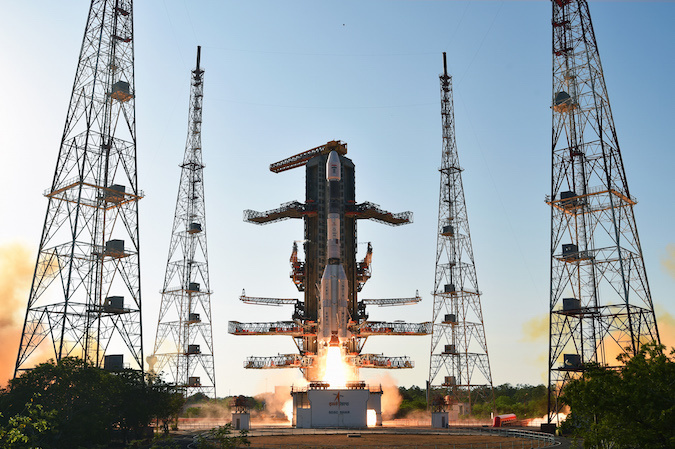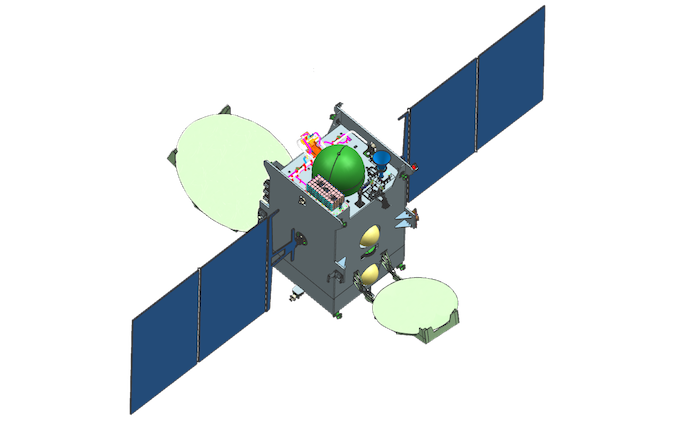India launches satellite, uniting its South Asian neighbors
May 6, 2017, Stephen Clark (Stephen Clark)

Geosynchronous satellite launch vehicle ( GSLV ) launches from the Satish-Dhavan cosmodrome on the east coast of India (May 5, 2017) (c) Indian Space Research Organization ( IOCI )
On May 5, 2017, under cover of secrecy, the Indian rocket launched with a two-ton satellite to relay video broadcasting and data between India and its South Asian neighbors.
Built in India, the GSAT-9 telecommunications satellite was launched from the Satish-Dhavan cosmodrome, which is located on the east coast of India. The 49-meter rocket dispersed the satellite 17 minutes after its launch before it reached an elliptical geo-transitional orbit.
The launch of the GSLV Indian rocket occurred on May 5, 2017 at 11:27 GMT or at 16:57 local time of the cosmodrome.
Usually, OKI releases technical brochures about its missions and provides live broadcasts of rocket launches. However, this time the country’s space agency did not publish the launch details in advance and did not provide the broadcast of the launch live.
IOKI’s mission brochure appeared on its website shortly after officials announced a successful launch. According to IOKI, the GSAT-9 satellite, also known as the South Asian Satellite, made contact with the ground control station in Hassan, India, immediately after entering open space.
The GSLV-v2 rocket launched a 2,230-kilogram GSAT-9 satellite into an initial geo-transition orbit with an altitude of 169 km at perigee and 36,105 km at apogee, which is very close to the parameters calculated before launch.

Artistic image of the satellite GSAT-9 © IOKI
After that, the jet engines onboard the GSAT-9 satellite began to make maneuvers in order to turn an elliptical orbit into a circular orbit on Saturday, May 6, raising the perigee on each revolution around the Earth and shifting the satellite orbit closer to the equator.
In the following weeks, GSAT-9 will move to a working position at 48 degrees east longitude in geostationary orbit, after which it will turn on 12 of its transponders at Ku-frequency for verification before providing services to users in India, Bangladesh, Sri Lanka, and Maldives in Nepal, Bhutan and Afghanistan.
Indian Prime Minister Narendra Modi, who announced plans for communications satellites destined for India’s neighbors in 2014, welcomed the mission during a videoconference with leaders of South Asian countries after launch.
"Today is a historic day for South Asia, a day which has not yet been," said Modi. “Two years ago, India made a promise, a promise to expand access to advanced space technologies for the growth and prosperity of our brothers and sisters in South Asia.”
"The successful launch of the South Asian Satellite marks the fulfillment of this promise," continued Modi. “With this launch, we started the path to building the most developed border of our partnership. From its position high in the sky, this symbol of South Asian assistance will meet the aspirations for economic progress of more than one and a half billion people in our region, and expand our close ties into open space. ”
Modi described the South Asian Satellite as a “gift” from India to his neighbors in the South Asian Association for Regional Cooperation, who will have access to the communication capabilities of the device for free. However, each country itself is responsible for having its own ground facilities for communication with the satellite.
At the same time, Pakistan, the second largest member of the South Asian Association, refused to be part of the project.
The South Asian Satellite project cost the government of India more than $ 60 million, according to a report published by The Hindu.
“The world should pay attention to the fact that South Asia has made a giant step today towards regional cooperation and our people will be much better together,” said President of Afghanistan Ashraf Ghani. “If assistance through the earth is impossible, it is definitely possible through the sky.”

GSLV starts on Friday, May 5, 2017 from the Satish-Dhavan cosmodrome on the east coast of India. One can see the thermal insulation pieces falling from the rocket. (c) IOKI
The life of the GSAT-9 is designed for 12 years. The satellite has 4 stationary plasma engines onboard to demonstrate the technology of an electrojet propulsion system. These low-power plasma engines can also act as spare for conventional chemical jet engines of a satellite.
Officials said that GSAT-9 will provide television and video broadcasts, link health and education institutions, distribute meteorological data and help governments respond to natural disasters.
“The launch of the South Asian Satellite today is a historic moment for the world,” said Bhutan’s Prime Minister Tobgay Tsering. “It’s historic because for the first time the country launched a satellite for free use by its neighbors.”
This launch was the fourth consecutive successful launch for the Indian GSLV rocket, more than one of the country's two active missiles. GSLV-v2, which is currently in use, has a cryogenic upper stage developed in India, which uses liquid hydrogen and liquid oxygen, replacing the upper stage previously developed in Russia, which was used until 2010.
Overall, the official GSLV rocket's official track record, starting from the time it debuted in 2001 and including its early variations with Russian equipment, now amounts to 7 successful launches out of 11.
The launch on May 5, 2017, officially designated as GSLV-F09, was the second space launch of India this year, after the launch of a carrier rocket on February 15 to launch the PSLV polar satellites with 104 satellites on board. The PSLV rocket, smaller in size, has a track record of already 38 successful launches in a row, thus creating a niche for itself in the global launch market of light satellites for the needs of foreign companies and governments.

Geosynchronous satellite launch vehicle ( GSLV ) launches from the Satish-Dhavan cosmodrome on the east coast of India (May 5, 2017) (c) Indian Space Research Organization ( IOCI )
On May 5, 2017, under cover of secrecy, the Indian rocket launched with a two-ton satellite to relay video broadcasting and data between India and its South Asian neighbors.
Built in India, the GSAT-9 telecommunications satellite was launched from the Satish-Dhavan cosmodrome, which is located on the east coast of India. The 49-meter rocket dispersed the satellite 17 minutes after its launch before it reached an elliptical geo-transitional orbit.
The launch of the GSLV Indian rocket occurred on May 5, 2017 at 11:27 GMT or at 16:57 local time of the cosmodrome.
Usually, OKI releases technical brochures about its missions and provides live broadcasts of rocket launches. However, this time the country’s space agency did not publish the launch details in advance and did not provide the broadcast of the launch live.
IOKI’s mission brochure appeared on its website shortly after officials announced a successful launch. According to IOKI, the GSAT-9 satellite, also known as the South Asian Satellite, made contact with the ground control station in Hassan, India, immediately after entering open space.
The GSLV-v2 rocket launched a 2,230-kilogram GSAT-9 satellite into an initial geo-transition orbit with an altitude of 169 km at perigee and 36,105 km at apogee, which is very close to the parameters calculated before launch.

Artistic image of the satellite GSAT-9 © IOKI
After that, the jet engines onboard the GSAT-9 satellite began to make maneuvers in order to turn an elliptical orbit into a circular orbit on Saturday, May 6, raising the perigee on each revolution around the Earth and shifting the satellite orbit closer to the equator.
In the following weeks, GSAT-9 will move to a working position at 48 degrees east longitude in geostationary orbit, after which it will turn on 12 of its transponders at Ku-frequency for verification before providing services to users in India, Bangladesh, Sri Lanka, and Maldives in Nepal, Bhutan and Afghanistan.
Indian Prime Minister Narendra Modi, who announced plans for communications satellites destined for India’s neighbors in 2014, welcomed the mission during a videoconference with leaders of South Asian countries after launch.
"Today is a historic day for South Asia, a day which has not yet been," said Modi. “Two years ago, India made a promise, a promise to expand access to advanced space technologies for the growth and prosperity of our brothers and sisters in South Asia.”
"The successful launch of the South Asian Satellite marks the fulfillment of this promise," continued Modi. “With this launch, we started the path to building the most developed border of our partnership. From its position high in the sky, this symbol of South Asian assistance will meet the aspirations for economic progress of more than one and a half billion people in our region, and expand our close ties into open space. ”
Modi described the South Asian Satellite as a “gift” from India to his neighbors in the South Asian Association for Regional Cooperation, who will have access to the communication capabilities of the device for free. However, each country itself is responsible for having its own ground facilities for communication with the satellite.
At the same time, Pakistan, the second largest member of the South Asian Association, refused to be part of the project.
The South Asian Satellite project cost the government of India more than $ 60 million, according to a report published by The Hindu.
“The world should pay attention to the fact that South Asia has made a giant step today towards regional cooperation and our people will be much better together,” said President of Afghanistan Ashraf Ghani. “If assistance through the earth is impossible, it is definitely possible through the sky.”

GSLV starts on Friday, May 5, 2017 from the Satish-Dhavan cosmodrome on the east coast of India. One can see the thermal insulation pieces falling from the rocket. (c) IOKI
The life of the GSAT-9 is designed for 12 years. The satellite has 4 stationary plasma engines onboard to demonstrate the technology of an electrojet propulsion system. These low-power plasma engines can also act as spare for conventional chemical jet engines of a satellite.
Officials said that GSAT-9 will provide television and video broadcasts, link health and education institutions, distribute meteorological data and help governments respond to natural disasters.
“The launch of the South Asian Satellite today is a historic moment for the world,” said Bhutan’s Prime Minister Tobgay Tsering. “It’s historic because for the first time the country launched a satellite for free use by its neighbors.”
This launch was the fourth consecutive successful launch for the Indian GSLV rocket, more than one of the country's two active missiles. GSLV-v2, which is currently in use, has a cryogenic upper stage developed in India, which uses liquid hydrogen and liquid oxygen, replacing the upper stage previously developed in Russia, which was used until 2010.
Overall, the official GSLV rocket's official track record, starting from the time it debuted in 2001 and including its early variations with Russian equipment, now amounts to 7 successful launches out of 11.
The launch on May 5, 2017, officially designated as GSLV-F09, was the second space launch of India this year, after the launch of a carrier rocket on February 15 to launch the PSLV polar satellites with 104 satellites on board. The PSLV rocket, smaller in size, has a track record of already 38 successful launches in a row, thus creating a niche for itself in the global launch market of light satellites for the needs of foreign companies and governments.
All Articles